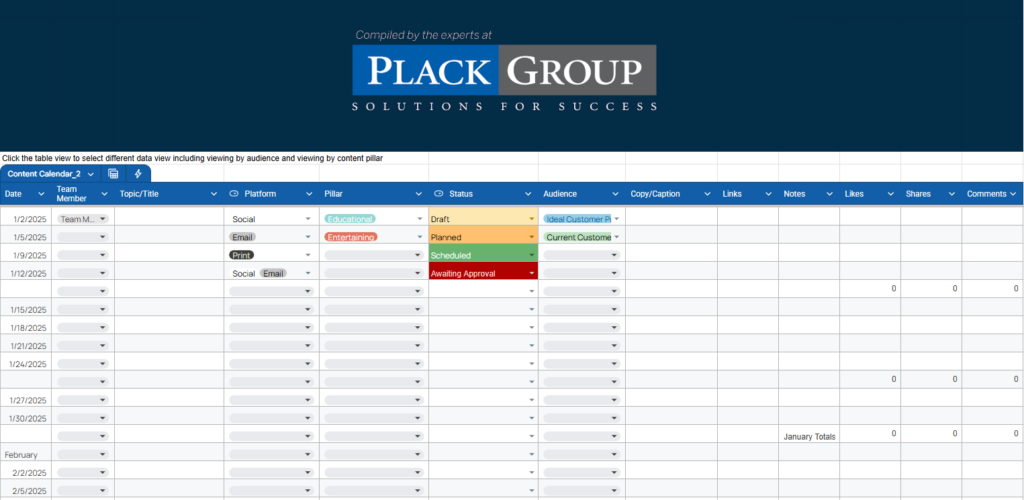The Importance of a Content Calendar and How to Get Started
By Emily O’Neil
A content calendar is more than just an organizational tool, it’s a strategic asset for successful small business owners and their COOs who need to manage marketing teams efficiently while balancing multiple priorities. In today’s fast-paced digital landscape, a well-maintained content calendar transforms ad-hoc, stressful content creation into a streamlined, results-driven process that supports business growth, even if marketing isn’t your core expertise.
Want access to a ready made content calendar template on Google Sheets? Email Emily O’Neil at [email protected] to gain access or click here to download the Excel version

Why a Content Calendar Matters for Your Business
- Consistency Builds Trust and Visibility
Maintaining a regular posting schedule keeps your brand top-of-mind for your audience. Consistency fosters trust, strengthens your reputation, and encourages ongoing engagement, which is critical for long-term business relationships. - Enhanced Organization and Workflow
A content calendar centralizes your content planning, making it easy to track what’s coming up, manage deadlines, and avoid last-minute scrambles. This level of organization reduces stress and ensures nothing falls through the cracks. - Strategic Alignment with Business Goals
Planning content in advance allows you to align marketing efforts with key business events, product launches, and industry trends. This ensures your marketing supports your broader business objectives and maximizes impact. - Operational Efficiency
By mapping out content needs ahead of time, you can batch-create assets, streamline approvals, and delegate tasks efficiently, saving valuable time for both you and your team. - Improved Team Collaboration
A shared calendar increases transparency across your marketing team, clarifies responsibilities, and keeps everyone accountable. This is especially important for COOs or leadership overseeing cross-functional teams or external partners. - Comprehensive Coverage and Audience Focus
Seeing your content plan at a glance helps ensure you’re addressing all target audiences, covering essential topics, and avoiding overlaps or gaps in your messaging.

How to Get Started with a Content Calendar
1. Define Your Marketing Goals
Start by clarifying what you want to achieve: brand awareness, lead generation, customer retention, or something else. Your goals will shape your content themes, formats, and publishing cadence.
2. Choose the Right Tool
Select a platform that fits your workflow and team size. Options range from simple spreadsheets to robust project management tools like Trello, Asana, or dedicated content calendar solutions such as HootSuite. Want access to a ready made Content Calendar template on Google Sheets? Email Emily O’Neil at [email protected] to gain access
3. Identify Key Dates and Events
Populate your calendar with important business milestones, industry events, product launches, and relevant holidays. This ensures your content is timely and aligned with what matters most to your business and audience.
4. Map Out Content Types and Channels
Determine your core content pillars (informative, educational, customer spotlights, etc) and assign publishing frequencies. Tailor your approach to the channels your audience uses most.
5. Assign Responsibilities and Deadlines
Clearly define who is responsible for creating, editing, and publishing each piece of content. Include deadlines for drafts, reviews, and final publication to keep your team accountable and on track.
6. Plan Ahead, But Stay Flexible
Aim to fill your calendar at least a month in advance. However, leave space for timely topics or unexpected opportunities; your calendar should guide, not restrict, your team.
Practical Implementation Tips
- Batch Content Creation
Dedicate regular time blocks to create multiple pieces of content at once. This approach increases efficiency and helps maintain quality, especially when working with defined content pillars. - Regularly Review and Optimize
Analyze your calendar’s performance using metrics like engagement, traffic, and conversions. Adjust your strategy based on what resonates with your audience and supports your business goals. - Integrate with Broader Marketing Initiatives
Use your content calendar to coordinate messaging across all marketing channels (social media, email, blog, and paid campaigns)for a unified brand presence. - Keep It Simple and Scalable
Start with a basic structure and add complexity only as your marketing operation grows. The goal is to make your marketing easier to manage, not more cumbersome.
A well-maintained content calendar is your roadmap to stress-free, effective marketing, helping you stay organized, consistent, and strategic, even if marketing isn’t your primary role.

Key Elements to Include in Your Content Calendar
| Element | Description |
| Publication Date | When each piece of content will go live |
| Content Type | Blog, social media post, newsletter, video, etc. |
| Title/Topic | Working title or main theme for each piece |
| Responsible Person | Team member assigned to create/edit/publish |
| Channel | Where the content will be published (website, LinkedIn, Instagram, etc.) |
| Status/Deadline | Current status (draft, in review, scheduled) and key deadlines |
| Performance Metrics | Space to track engagement, traffic, conversions post-publication |
Final Thoughts
A documented content calendar is a hallmark of high-performing marketing teams. For small business owners and COOs, it’s a proven way to bring structure, clarity, and measurable results to your marketing efforts, freeing up more time to focus on what you do best: running and growing your business.
By investing a small amount of time upfront to set up and maintain a content calendar, you’ll empower your marketing team to operate more strategically, collaborate more effectively, and deliver consistent, high-quality content that drives real business results.
Plack Group: Who We Are
Founded on a simple yet powerful principle – helping people – Plack Group is more than just an accounting firm. We create effective solutions that embody your core values and beliefs. From our home in Bel Air, Maryland, we’re proud to serve kind and dedicated clients across the United States.
We’ll say what others might not: we love our clients. Our commitment extends far beyond tax returns and financial analysis. We offer the same thoughtful guidance and strategic advice we’d give our own family.
At Plack Group, we take a highly personalized approach to helping our clients succeed. No two businesses or people are alike, so why would we treat them that way? We specialize in complex tax scenarios for individuals in the highest tax brackets and business owners. Our experienced team of CPAs, accountants, and consultants find solutions and tax strategies others miss.
If you’re a high-achiever, forward-thinker, actively engaged in your business, and want to prioritize your family, Plack Group is your right fit. We work with you to create a strong financial future that reflects your personal faith, values, and beliefs.



